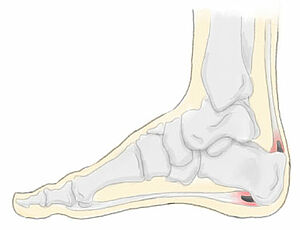Heel spurs
Heel spurs
Heel spurs in athletes Heel spurs are a common problem in running sports. Runners often complain about pain under their heels or along the plantar plate, the tendinous tissue running along the bottom of the foot. The symptoms occur most significantly during running activities. Above all, many reports describe symptoms in the morning, just after getting up. The heel spur itself is usually not the problem, but rather plantar fasciitis — inflammation of the plantar fascia, the thick band of tissue that runs across the bottom of the foot and supports the foot's arch. In running sports, this area is subjected to particular strain, where chronic inflammation of the plantar plate results in osseous outgrowths. The image seen on the X-ray is then referred to as a heel spur. Runners experience such strong pain at this localization that every load applied during running and even everyday life is torturous. Heel spur therapy primarily aims to remedy the pain in the area around the heel spur. However, a decisive factor for long-term therapeutic success to remedy incorrect loading of the plantar plate is regular training of the foot muscles using appropriately customized PROPRIO® foot orthoses. Heel spurs in pain sufferers Approximately 10% of the world's population has heel spurs. These often occur randomly without clinical signs or symptoms. When X-rayed, calcifications shaped like spurs are visible at the site where the plantar plate of the foot sole attaches to the calcaneus.
Heel spurs in pain sufferers
Approximately 10% of the world's population has heel spurs. These often occur randomly without clinical
signs or symptoms. When X-rayed, calcifications shaped like spurs are visible at the site where the plantar
plate of the foot sole attaches to the calcaneus.
www.proprio.info à Expert Search
PROPRIO — The sensorimotor foot orthosis
The cause is frequently overloading of the plantar plate due to instability in the arch of the foot. Every step
exerts tensile forces and improper loading on these structures. The body reacts by depositing bone material at
this site as a sort of "filler".
The triggered pain restricts the quality of life of those affected to a high degree, sometimes making
impossible to bear weight on the heel. Problems tend to be particularly severe in the morning. The sufferer's
physician will generally prescribe physiotherapy and foot orthoses.
Laypersons usually presume that the pain is triggered by the bone spurs themselves. However, in actuality, it
is not the spur itself that causes the pain, but the inflammatory reaction at the tendinous attachment of the
plantar plate. The periosteum around the spurs often becomes sensitive as well. That is why it makes little
sense to simply cut a hole in the foot orthosis and hope that this will provide relief for the heel spur. On the
